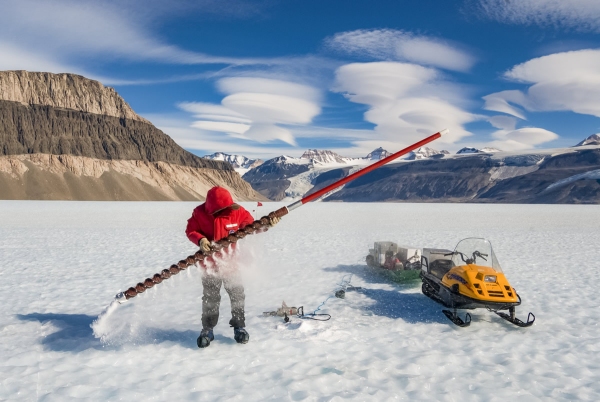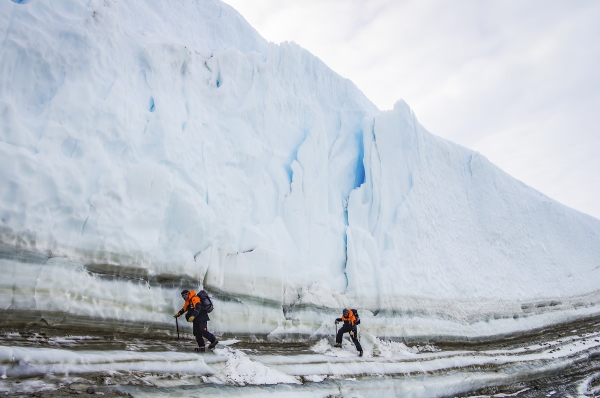Sitting at the surface of Taylor Glacier in Antarctica, are layers of ice more than 10,000 years old. And trapped inside those layers are bubbles of ancient air – like tiny time capsules - able to tell scientists a story about what the world used to be like and how humans have changed it.
Today in the latest edition of prestigious scientific journal, Nature, a new paper reveals - after six years of extraordinarily complex and precise research - exactly what that story is.
NIWA atmospheric scientist Dr Hinrich Schaefer has been part of a team of researchers, led by the University of Rochester in the US, to have made a significant discovery about the emissions of methane, a powerful greenhouse gas, that could alter how countries tackle reducing global warming.
The research challenges conventional thinking about the amount of methane seeping out naturally from oil and gas fields. The team found evidence that this is a fraction of what had previously been thought.
Consequently, the team concludes, methane emissions from industrial fossil fuel use and extraction are far greater than realised.
To reach these conclusions has required some extraordinary science that, due to its complexity, has never been attempted before. To start with, the researchers harvested a tonne of 11,000-year old ice to produce 100 litres of ancient air and then repeated the process more than 10 times.
Sample processed to isolate pure methane
Once the air had been extracted, NIWA processed the sample to isolate the pure methane – a procedure that results in a sample equal in size to a drop of water. That is then sent to a highly specialised laboratory in Australia for radiocarbon dating.
“Of the methane sample - as small as a drop of water - only every trillionth molecule contains a radiocarbon atom. We pushed the limits of our instruments to new levels and then analysed how that minute quantity changed 11,000 years ago.
“This enabled us to calculate how big the emissions of fossil methane were at a time before industrial activities and how this responded to rapid warming at the end of the last ice age,” Dr Schaefer said.
The scientists started with two questions:
- How much fossil methane escapes naturally into the atmosphere and how much is due to industrial activity?
- How much stored methane was released into the atmosphere during rapid warming at the end of the last ice age?
Answering the former would indicate exactly how humans are responsible for increasing levels of methane, and a solution to the latter would indicate what is likely to happen in the future as global warming continues.
Dr Schaefer said results showed the amount of methane escaping naturally from gas fields was three to four times less than previously estimated. Further, when the climate warmed in the past, methane was not released from ancient carbon reservoirs like permafrost or undersea gas hydrates, so would not be a factor in future climate change.
Industrial methane output is twice as much as natural
“We have a reasonable idea today of the total amount of methane coming out of oil and gas fields but how to split that up between natural seepage and industrial emissions is very difficult. The best guess we have been working with is that industrial methane output is twice as much as natural.
“However, from this research we know that there is very little natural emission. In fact, our higher limit is a lot less than what has been regarded even as the lowest possible estimate. Consequently, the industrial emissions have been underestimated by about half their size.”
Dr Schaefer says the research has two main implications:
- If we know that the emissions are caused by industry or human activity, it means we have a chance to reduce them. “If they are naturally occurring there is nothing we can do about it.”
- There is a possible scenario that increasing global warming will trigger greater amounts of natural methane emission that will exacerbate the problem. However, this work shows that huge natural stores of methane did not react to the end of the ice age and the team is hopeful that these reservoirs are less prone to warming.
“It is clearly important to our understanding of where methane comes from and what our human activities do to change the levels in the atmosphere. So it gives us a warning of where we have to put in more effort and where we can make a difference.”
Last year Dr Schaefer led breakthrough research that showed rising methane levels since 2007 were most likely due to agricultural practices, and not fossil fuel production as previously thought.
“This latest research shows we have to target both fossil fuel and agricultural emissions. Agriculture has been playing a large role in recent years, but it is also essential to target fossil fuel emissions because historically they have had a bigger impact than we thought they had,” he said.
View the Nature paper: Minimal geological methane emissions during the Younger Dryas–Preboreal abrupt warming event.


